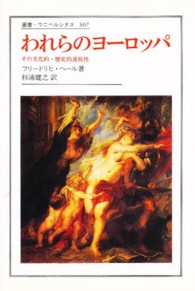- ホーム
- > 洋書
- > ドイツ書
- > Humanities, Arts & Music
- > Arts
- > architecture
Description
(Text)
Taschkent, die Hauptstadt Usbekistans, wurde im Laufe ihrer Geschichte von verschiedenen Kulturen geprägt. Nach dem Erdbeben von 1966, das die städtische Infrastruktur weitläufig zerstörte, wurde die Stadt von Architekt:innen aus der gesamten Sowjetunion in Zusammenarbeit mit lokalen Expert:innen umfassend wiederaufgebaut. Die daraus resultierende modernistische Architektur aus den Jahren 1964-1991 ist einzigartig in Taschkent und spiegelt das facettenreiche soziale Gefüge der Stadt wider.Diese Publikation vereint die Materialien des Projekts «Tashkent Modernism XX/XXI», Projekts, für das ein internationales Team an Architekt:innen, Historiker:innen und Restaurationsexpert:innen gemeinsam das modernistische Erbe der Stadt aufgezeichnet und wiederhergestellt hat. Dieses umfassende Buch präsentiert Forschungsergebnisse sowie Erkenntnisse, die die Werke in einen breiteren Rahmen der usbekischen und sowjetischen Geschichte einordnen. Es bietet einen strategischen Plan für die Konservierung und Erhaltung dieses wichtigen architektonischen Erbes, im Einklang mit Bestrebungen zur Erhaltung von modernistischer Architektur auf globaler Ebene.Die Publikation besteht aus zwei Teilen. Der erste Band enthält eine Reihe von schriftlichen und visuellen Essays, während der zweite Teil fünfzehn Gebäudemonografien umfasst, die Geschichte, Schutzverzeichnisse und Interventionsstrategien für die ausgewählten Gebäude darlegen.Initiiert und in Auftrag gegeben durch die Art and Culture Development Foundation von Usbekistan.
(Text)
Given its geographical location, developed resources and multicultural history, Tashkent, the capital of Uzbekistan, continues to be one of the most important centers of Central Asia. Since the Soviet era, numerous efforts were made to conserve and restore architectural monuments that speak to the rich ancient and medieval history of the region. By contrast, the modernist architecture of the 1960s-1980s, which articulated the idea of a modern, forward-looking society, was never perceived as heritage. With the arrival of the market economy and after the independence of Uzbekistan in 1991, the architecture of the previous three decades, which focused on social issues and economy of means, lost relevance. Today, this modernist layer of Tashkent is gaining recognition as a unique artistic, cultural and social phenomenon that is best equipped to reveal the specific character of the modernization of Soviet Central Asia. More than just another "peripheral case" of multiple modernities or a point on the global map of twentieth-century architectural modernism, this architecture is relevant to the global cultural scene, reflecting the radical aspects of the Soviet social and cultural experiment. This publication combines the materials of the Tashkent Modernism XX/XXI project, for which an international team of architects, historians and restoration experts joined forces on recording and restoring the city's modernist legacy. This comprehensive book presents research results alongside insights that contextualize the work in a broader framework of Soviet and Uzbekistan history. It provides a strategic plan for conservation and adaptation of this important architectural heritage which resonates with preservation ambitions of modernist architectures on a global scale.The publication consists of two parts. The first part contains a series of written and visual essays, while the second encompasses twelve building monographs that present histories, protection inventories and intervention strategies for the selected buildings.Initiated and commissioned by the Art and Culture Development Foundation of Uzbekistan.






